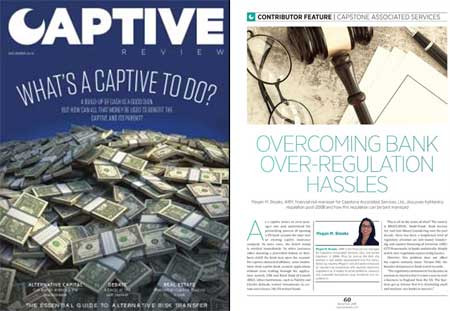 As a captive owner or even manager, one may understand the painstaking process of opening a U.S. bank account for your new or existing captive insurance company. In some cases, the denial stamp is wielded immediately. In other instances, (after donating a proverbial kidney or first-born child), the bank may open the account. For captives domiciled offshore, some institutions deny captive bank account applications without even reading through the application; namely UBS and Royal Bank of Canada (“RBC”). Other institutions, such as Fidelity and Charles Schwab, restrict investments in certain asset classes, like U.S. mutual funds.
As a captive owner or even manager, one may understand the painstaking process of opening a U.S. bank account for your new or existing captive insurance company. In some cases, the denial stamp is wielded immediately. In other instances, (after donating a proverbial kidney or first-born child), the bank may open the account. For captives domiciled offshore, some institutions deny captive bank account applications without even reading through the application; namely UBS and Royal Bank of Canada (“RBC”). Other institutions, such as Fidelity and Charles Schwab, restrict investments in certain asset classes, like U.S. mutual funds.
This is all in the name of what? The answer is REGULATION--Dodd-Frank, Bank Secrecy Act, and Anti-Money Laundering. Over the past decade, there has been a heightened level of regulatory attention on anti-money laundering and counter-financing of terrorism (AML/CFT) frameworks in banks unilaterally. Simply stated, over-regulation equates to big hassles.
However, this problem does not affect the captive industry alone. Vernon Hill, the Founder of Commerce Bank stated recently, “The regulatory environment has become so onerous in America that it is now easier to start a business in England than the U.S. The burdens get so intense that it is destroying small and medium-size banks in America.”
Hill would know as he started his first branch in 1973 at age 27. He grew his business into a 460-branch financial institution with combined deposits of $40 billion dollars. He eventually sold his business to TD Ameritrade for $8.5 billion.
Unfortunately, it’s not only the banks that are feeling the pressure. Over-regulation affects small and middle market business, restricting lending for some and closing bank accounts for others; the Feds have taken anti-money laundering rules to the extreme.
“Know Your Customer” Evolves Into “Know Your Customer’s Customer”

Megan M. Brooks, ARM
Vice President, Operations
Capstone Associated Services, Ltd.
---------------------------------------------
Know your Customer (“KYC”) is the practice whereby businesses identify their customers; it is essentially a customer-identification program mandated under the acts and regulations issued by Congress and supervisory authorities. The KYC policies are largely applied from banks and other financial institutions, not only to prevent identity theft fraud, money laundering and terrorist financing, but also to regulate the risks in business lending and investment banking activities between banks and their customers. The financial crisis of 2008 proved that commercial lenders’ and financial institutions’ loose practices led to a meltdown and though there is no clear evidence, KYC was not properly adhered to. Many believe stricter adherences to the framework can only have a positive effect of the markets.
De-risking
Since 2008, the enactment of Dodd-Frank compliance efforts have gone well beyond the previous industry standard of “Know Your Customer;” questions have become more intrusive even to go as far in some cases to research bills of lading to ensure the source of funds. Banks are now following the “Know Your Customer’s Customer” mantra, due to increased regulation. It has caused some banks to back away from some lines of business and certain clients; a concept termed “de-risking.”
De-risking has led some institutions to opt out of long-term relationships with clients deemed “high-risk.” Banks must conduct more intensive due diligence for potential clients and the questions are becoming increasingly intrusive. Some experts believe that in the next five years as technology allows more microscope transaction monitoring, the banking industry may step away from client identity and verification and focus more on drilling down into the account transactions. Delving deeper into the client transactions would allow for banks to monitor cash flows and be able to identify suspicious transactions.
Where should the bank and the public draw the line with regulators? Or can they?
Regulators swear they simply want banks to manage risk; however, bankers are de-risking and deciding that certain geographic areas and lines of business are just too expensive to profitability serve. De-risking, the new norm in the bank industry, has become extremely costly not only in efforts to adhere to the strict compliance, but ultimately in costing banks new business.
Though captive insurance companies have existed for decades, it is a relatively new industry for the micro-captive, also referred to as 831(b). As with anything new, the captive industry has its own set of naysayers and critics, including the Internal Revenue Service (“IRS”) which attempted to thwart the industry by using unfounded propaganda titled, “The Dirty Dozen”.
Will this negative attention cause the captive industry to be a victim of bank de-risking, creating a high-risk reputation for captive insurance companies? For the large institutions, captive bank accounts are a drop in the bucket but for small and medium-sized banks, loss of these new accounts can be more significant. It is the heavy hand of excessive government regulation that is killing the small and middle-markets of the U.S.; due diligence is only going in one direction… growing in levels and increasingly intrusive.
Risk-Based Approach
So simply stated, captive owners, you are not alone. The banking industry is suffering the woes of regulation along with you. However, when faced with the AML/Compliance departments of these fine financial institutions, it is imperative that you have a strong captive manager to help you navigate the barrage of questions and requirements that will surely come your way. Your captive manager should also help you select a financial institution that is right for you. There is no reason to be a victim of de-risking.
By selecting a reputable captive manager, a captive owner can benefit from established banking relationships and a captive management staff that has extensive experience dealing with compliance departments. As the assets of the captive begins to grow, one may choose to diversify the captive portfolio and begin to invest in other types of financial instruments. An established captive manager can introduce you to financial advisors that have worked in the captive industry. Captive insurance companies are regulated entities and each domicile has its own set of guidelines and regulations which can be extremely cumbersome.
The progression of regulation is unstoppable; however there is no reason to navigate the waters of regulation alone whether it is banking regulation or captive regulation. Just as the financial institutions utilize a risk-based approach in the process of de-risking current banking relationships or assessing new clients, the proper selection of a captive manager follows similar, careful steps: i) identify the options, ii) meet the captive manager and speak to referrals, iii) assess all options, iv) select a captive manger, and v) always stay engaged, provide information, and give feedback and finally, vi) know your captive manager. A great captive manager communicates and listens.
Throughout the captive manager selection process, the important factors to consider in selecting a captive manager include: how long they have been in the captive management business, how strong is their commitment to regulatory compliance, whether or not they take an interdisciplinary approach with appropriate input from legal, tax, and accounting professionals, and the type of experience the captive management staff has. Captive insurance is a complex alternative risk planning tool; it is important to have the right captive experts on your side.
Written by Megan M. Brooks, ARM, Vice President, Operations at Capstone Associated Services, Ltd.
Download a pdf copy of this report here.




